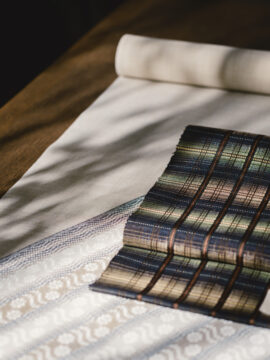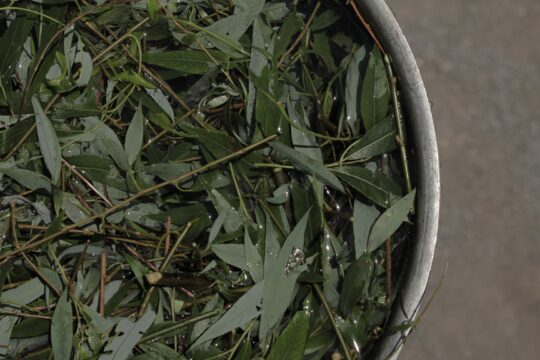
This year marks the 30th anniversary of Ginza Motoji Co., Ltd., a kimono retailer, which has been working on "Ginza Willow Dyeing", a dye made from willow trees in Ginza. To celebrate this special anniversary, a special commemorative exhibition featuring "Ginza Willow Dyeing" will be held at two stores, "Ginza Motoji Washomen" and "Otoko no Kimono", as well as the official online store, from Friday, April 5th to Sunday, April 7th, 2024.
This time, willow will be sent to crafters all over the country in the summer of 2023, and over 40 works created by 18 dyeing, weaving, and embroidery artists and two production areas will be gathered at Ginza Motoji. Although they are dyed from the same Ginza willow, they are all one-of-a-kind obi and haori cords that show unique and diverse expressions.

Front) Eiko Nishiyama's floating 9-inch Nagoya obi "The Echo of Life"
Center) Tsumugi-ori 9-inch Nagoya obi "Rainy Night" by Miyuki Otaka
Back) Authentic summer Yuki kimono fabric, stripes
The beginning of "Ginza Willow Dyeing" <br /> Although dyeing using local plants can be found all over the country, "Ginza Willow Dyeing" is an original Ginza Motoji product that uses the life color of the "willow" that lives flexibly in the big city of Ginza. Every year, pruned willow branches and leaves that grow from spring to early summer are sent to artists and production areas around the country, and the dyed works that each artist creates are then returned to Ginza Motoji stores. This popular project began 30 years ago.
In 1993, when the Ginza Motoji store was still located on Yanagi-dori Street in Ginza 1-chome, founder Hiroaki Senji happened to look up at the sky and saw yellow-green willow buds swaying in the wind, sparkling. Struck by their pure beauty, Senji came up with the idea of "how to express the life of these willows through natural dyeing." After that, he learned that the Chuo Ward prunes and disposes of willows in Ginza every year, and established a system to have the pruned willow branches and leaves distributed to stores.
However, the process was difficult because the willow plant itself was not as suitable for plant dyeing as traditional plants. As a result, with the cooperation of artists from all over the country who had built deep relationships of trust with our store, we established "Ginza Willow Dyeing," which continues to this day. Depending on the growth of the plants, the season they were harvested, and the mordant, we were able to create attractive works that produced a variety of colors each year.
The History of Ginza and Willows <br /> Ginza and willows have a deep connection, dating back to the Meiji period. In 1874 (Meiji 7), in an attempt to plant street trees on par with those in Europe and the United States, three types of trees – cherry, pine, and maple – were planted at the intersections of Ginza Street. However, as Ginza is reclaimed land, there is a lot of moisture in the soil, and the trees died, so willows, which can be grown in water, were chosen instead. At the time, willows were not the type of tree chosen to be used as street trees, so they looked fresh and became established as "Ginza willows." After that, the number of willows decreased dramatically due to historical damage such as the Great Kanto Earthquake and the Tokyo Air Raids, but willow planting activities started again in 1984, and willows were revived in Ginza as the "tree of Central Ward."
Ginza Motoji conveys the importance of dye culture to the next generation ~ Social contribution activities <br /> Since 1998, Ginza Motoji has continuously conducted the "Ginza Willow Dyeing Extracurricular Class" (for 5th grade elementary school students) at Ginza's only elementary school, Chuo Ward Taimei Elementary School. This year marks the 27th time. Through "Ginza Willow Dyeing," they continue to foster a love for their hometown and convey the joy of manufacturing to the next generation.
【detail】
■Event name: "Ginza Willow Dyeing" 30th Anniversary Exhibition – The Brilliance of Life"
https://www.motoji.co.jp/blogs/events/yanagizome202404
■ Period: Friday, April 5th, 2024 to Sunday, April 7th, 2024
■ Location: Ginza Motoji Washomen (4-8-12 Ginza, Chuo-ku, Tokyo), Otoko no Kimono (3-8-15 Ginza, Chuo-ku, Tokyo), official online shop
■Contact information: (Telephone reception hours: 11:00-19:00)
Ginza Motoji Japanese Dyeing 03-3538-7878 / Ginza Motoji Men's Kimono 03-5524-7472
■ Participating artists (18 people)
Unten, Y., Endo, S., Ohtaka, M., Kazuki, M., Kadomoto, Y., Okayama, Y., Kubohara, Y., Shimoi, N., Suga, K., Tsuiki, N., Nishiyama, E., Hirayama, Y., Fujiyama, C., Mori, Y., Yano, M., Yamagishi, K., Yamazaki, H., and Yanagi, S.
■Production area (2 production areas)
Yuki Tsumugi, Tamba cloth
■<Gallery Talk>
Date and time: Saturday, April 6, 2024, 10:00-11:00
Location: Ginza Motoji Waori Capacity: 40 people (free, reservation required)
Contents: Founder and current chairman of Ginza Willow Dyeing, Senji Hiroaki (first-generation owner), and second-generation owner Senji Keita look back on their 30-year history and talk about the spirit of tradition and willow dyeing nurtured in Ginza.
[About Ginza Motoji]
Founded in 1979, the company operates two stores in Ginza, Tokyo: Ginza Motoji Waori & Washomen, a store specializing in weaving and dyeing kimonos for women, and Ginza Motoji Otoko no Kimono, which opened in 2002 as Japan's first store specializing in men's kimonos.
The store introduces the splendor of Japanese handicrafts through works by Living National Treasures and Important Intangible Cultural Properties, as well as carefully selected kimonos and obi (dyed and woven items) from all over Japan. In addition, the store offers "face-to-face manufacturing" using silk threads from "Platinum Boy," the world's first purely male domestic silkworm variety, with a production history that can be traced back to a single thread, and an experiential project called "The Platinum Boy Story" where customers can have a one-of-a-kind kimono made from silkworms. The store has an Oshima Tsumugi weaving machine set up in the store, where customers can watch weavers weave cloth in "Oshima Tsumugi Born in Ginza," and regularly invites makers to hold talk sessions. As a bridge between customers and makers, the store values conveying in its own words what it has seen, heard, touched, and felt with its own eyes, ears, and hands, and delivers the story behind the kimono.
*"Ginza Willow Dyeing" is a registered trademark of "Ginza Motoji."
From the press release of Ginza Motoji Co., Ltd.
<Past related articles>
[Ginza Wako] "Matsudaken's World Exhibition" will be held from Thursday, April 25th
"Unseen Things Hidden in the City" Exhibition to be extended until March 24th (Sun)
